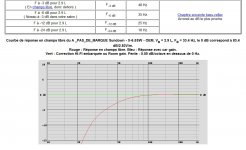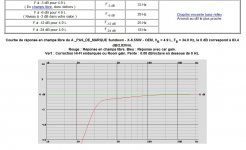IMHO, tapped horns and vented boxes ideally need a few things:
1) relatively high FS, because they're typically tuned below the FS spec
2) big excursion, because excursion raises output potential
3) Horn in particular work best with a small cone, because the overall size of the horn is tied to the horn throat and the horn mouth. (IE, if the cone is very big, horn size gets out of control.)
Based on that, this new woofer from Sundown looks pretty compelling. A 6.5" subwoofer.
More info here:
http://www.diymobileaudio.com/forum/1938017-post1.html
1) relatively high FS, because they're typically tuned below the FS spec
2) big excursion, because excursion raises output potential
3) Horn in particular work best with a small cone, because the overall size of the horn is tied to the horn throat and the horn mouth. (IE, if the cone is very big, horn size gets out of control.)
An externally hosted image should be here but it was not working when we last tested it.
Based on that, this new woofer from Sundown looks pretty compelling. A 6.5" subwoofer.
More info here:
http://www.diymobileaudio.com/forum/1938017-post1.html
I like this one as well...High-ish Fs, low Qts
300W Ultra Long Stroke 6 5" Competition Car Sub Kick Bass Sub Woofer Ice Speaker | eBay

300W Ultra Long Stroke 6 5" Competition Car Sub Kick Bass Sub Woofer Ice Speaker | eBay

IMHO, tapped horns and vented boxes ideally need a few things:
2) big excursion, because excursion raises output potential
IMO, with horns it's a good idea to keep an eye on velocity with these ultra high excursion drivers.
IIRC in my last horn with a tang band w6-1139 the velocity in the narrowest part of the horn was around 27 m/s at xmax, which is already pretty high and that driver has only 13 mm xmax.
IMO, with horns it's a good idea to keep an eye on velocity with these ultra high excursion drivers.
IIRC in my last horn with a tang band w6-1139 the velocity in the narrowest part of the horn was around 27 m/s at xmax, which is already pretty high and that driver has only 13 mm xmax.
While 27 m/s is quite fast, then again, this isn't airflow going in/out of a port which has abrupt ends (even considering radius'ing/flaring of the ends). I would suspect that airflow in the narrowest part of a horn is somewhat different than airflow across a sharp boundary. Have you done any testing with increasing power levels to see if the frequency response shifts or SPL compression (before coil power compression sets in)?
Two classic alignments for one, the first pic, ideal and second pic in sub mode alignment.
We have for max excursion (notice the following RMS is not the spec of max. W admissible by the manufacturer, but the theoretical W to achieve Xmax) in alignment #1 and #2 (Xmax = 15 mm, Xmech ~ 25.4 mm/1").
#1 (ideal-2.9 L) Xmech~25Hz - (Pmin) 2300/2600 W@3.6 Ohms
#2 (sub/4.9 L) Xmech~27Hz - (Pmin) 1600/2000 W@4 Ohms
The previous (simulation pics #1 and #2) and the next set of references are taken from the following forum/website (...)
Good candidates are Bass-reflex and Quarter wave types (or transmission line).
We have for max excursion (notice the following RMS is not the spec of max. W admissible by the manufacturer, but the theoretical W to achieve Xmax) in alignment #1 and #2 (Xmax = 15 mm, Xmech ~ 25.4 mm/1").
#1 (ideal-2.9 L) Xmech~25Hz - (Pmin) 2300/2600 W@3.6 Ohms
#2 (sub/4.9 L) Xmech~27Hz - (Pmin) 1600/2000 W@4 Ohms
The previous (simulation pics #1 and #2) and the next set of references are taken from the following forum/website (...)
Good candidates are Bass-reflex and Quarter wave types (or transmission line).
Here are specs with very little play time on the CCAW version :
Re : 2.9 ohms
Le : 0.44 mH
Fs : 44 Hz
Sd : 105.6 cm^2
BL : 11.282 TM
Qms : 8.7
Qts : 0.43
Qes : 0.46
Vas : 2.816 L
Cms : 117 uM/N
Mms : 75g
Sens : 79.1 dB 1w/1m
Ported box of 0.3 - 0.35 cubes tuned to 35-40 Hz looks very good.
Sundown 6.5 Subwoofer Project - Car Stereo Classifieds
Attachments
While 27 m/s is quite fast, then again, this isn't airflow going in/out of a port which has abrupt ends (even considering radius'ing/flaring of the ends). I would suspect that airflow in the narrowest part of a horn is somewhat different than airflow across a sharp boundary.
You suspect correctly. There is a difference. When there is an abrupt discontinuity (like a port exit, a throat chamber hole in a Nd flh, or even a brace with holes in it), we are dealing with boundary layer turbulence. But inside a port, or in the throat area of a tapped horn or OD flh where there is no abrupt discontinuity, we are concerned with core turbulence.
When I asked about this a couple years back, member revboden (IIRC) told me to use "Flare It" to find out safe velocity limits. Here's a quote from Flare It:
The blue line shows the velocity you can use at each frequency before boundary layer turbulence occurs (ie chuffing). This line moves as flare size or port diameter is changed
The red line shows the velocity you can use at each frequency before Core turbulence and compression occurs. This line only moves as port diameter is changed
Quote comes from here - Flare-it - Free Speaker Design Software - and that's also the download link.
Now, about the project I was talking about - the driver was the w6-1139 with 13 mm xmax. I used a very high compression ratio, S1 was only 25 sq cm. There were reasons for this high compression ratio which I can discuss if prompted but it's not really that important right now.
25 sq cm equates to a 5.5 cm diameter circle (roughly). So let's see what Flare It has to say about that.
An externally hosted image should be here but it was not working when we last tested it.
Remember, we're looking at the red line, acceptable limit before core turbulence sets in. Tuning for this project was approximately 35 hz, and at the frequency the red line shows about 19 or 20 m/s as being an acceptable limit. As I mentioned previously, Akabak showed about 27 m/s in the narrowest part of this horn at xmax.
Have you done any testing with increasing power levels to see if the frequency response shifts or SPL compression (before coil power compression sets in)?
I turned it up and listened to it but for a variety of reasons that's obviously not a complete scientific investigation. It did sound worse as it was turned up but there are a dozen different reasons that can happen and I didn't attempt to narrow down the dominant form of distortion as core turbulence (or a different cause).
I'm not really interested in defining absolute limits either, I'm happy to just be aware of the issue and try to keep velocity at reasonable limits.
And it should be noted that larger ports (and horn throat sections) can handle higher velocities before compressing, so as usual, bigger is better.
Last edited:
- Status
- This old topic is closed. If you want to reopen this topic, contact a moderator using the "Report Post" button.
- Home
- Loudspeakers
- Subwoofers
- (Possibly) A Killer Subwoofer for Vented Boxes and Tapped Horns

